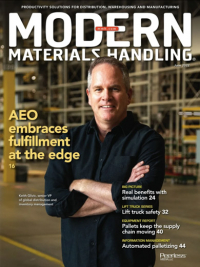Real benefits with simulation
Warehouses and fulfillment centers are increasingly automated, asset-intensive operations with multiple types of automation systems and robotics that need to work together to hit throughput goals. Consulting and assessments can identify likely solutions, but to get a solid prediction of what integrated systems can achieve, digital models and simulation are being widely used.
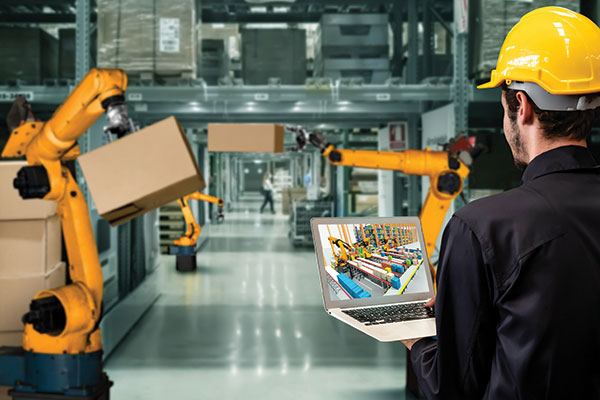
One of the best ways to know the rates you can achieve with warehouse automation is to mimic it first, in the digital world, using simulation.
Traditional methods of devising solutions, like on-site assessments by consultants, or visits to similar facilities and systems run by peers, remain important to identifying automation solutions, but simulation has emerged as a digital means of modeling—and predicting—the performance of systems before they’re fully configured and installed.
It’s all done with software, following the concept of creating a “digital twin” of an operation and its proposed systems, and using that model to test variables and “what-if” scenarios. Use of simulation by warehouse automation vendors, integrators and specialized consultants isn’t new, but it’s growing as warehouses become more automated, and user companies seek to combine multiple types of automation to hit throughput targets while minimizing labor needs.
Last year, research firm Interact Analysis predicted that e-commerce growth is driving the need to bring 28,500 new warehouses into service globally by 2025, while industrial real estate firm CBRE predicted that, in the United States alone, there’s a need for 330 million square feet of additional DC space by 2025. That out-sized need for warehousing only adds to the importance of understanding what simulation can do, not just to create spiffy graphics that show material flow, but to use simulation models to pinpoint how systems should be configured, and importantly, how they’ll react to swings in demand.
“One of the biggest questions that executives want to know is what will the capacity, the throughput, of this building and its systems will be,” says Richard Schrade, co-founder and president of Automation Intelligence, a simulation consulting firm. “Simulation provides objective answers to questions about the performance of proposed systems, because you are getting a 3D digital representation of what is going to happen in your eventual facility.”
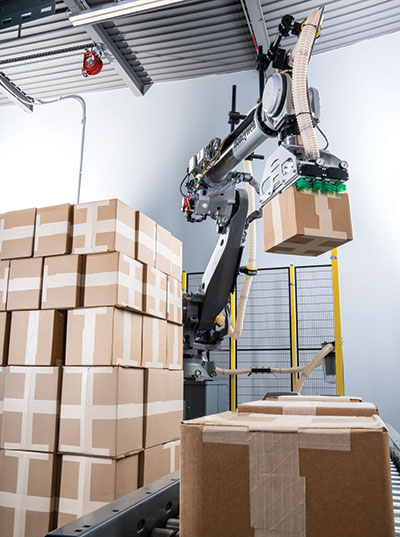
Simulation software, once a model of a to-be system if fully created, can be used to test many variables, such as adding more hardware like robots or picker workstations to automation systems planned for a site. What’s more, it can predict how multiple systems will work together, given end-user SKU and order volume data, to identify bottlenecks and arrive at the best balance between cost of the systems, and their ability to handle spikes in demand.
These capabilities cut right to the heart of end user concerns about effectiveness of solutions, says Kenneth Hayer, vice president of customer solutions with Swisslog, which has long used simulation as a tool in refining its automation solutions. “[Simulation] is really a tool to optimize a proposed design, to find where the bottlenecks are, and address those,” says Hayer. “You will really understand the behavior of integrated system much better when you do simulation.”
Simulation software has delivered value across many industries for decades, but it’s becoming more important in sectors like warehousing, which are becoming more automated, adds Tyler Phillips, global Emulate3D business development manager at Rockwell Automation.
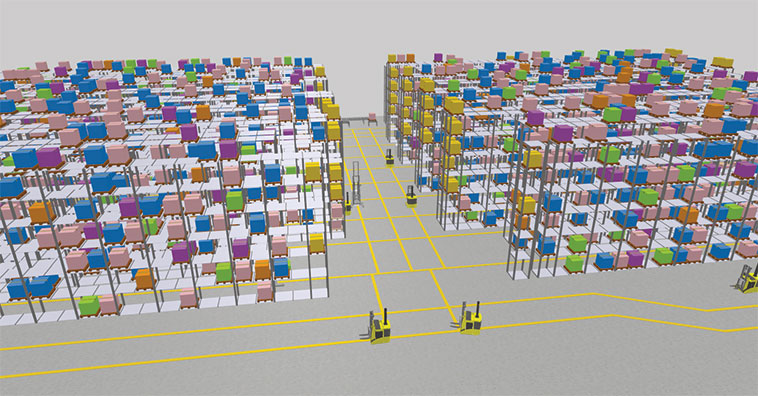
“If you are creating an automated warehouse, and it doesn’t meet capacity and performance requirements, that’s a huge problem, because it’s costly to fix, as opposed to a manual operation, where you could likely just throw some more people at the problem. Using a tool like Emulate3D to validate in advance that the systems being looked at will meet the prescribed requirements is extraordinarily valuable because it offsets an immense amount of risk and cost,” Phillips says.
Power of the model
Simulation modeling of proposed or would-be automated materials handling systems is often carried out by warehouse automation OEMs or a warehouse integrator, but not always. Automation IO, for example, carries out most of its simulation projects directly for end-user companies, using software from Emulate3D, which has been part of Rockwell Automation since Rockwell acquired the company in early 2019. Other well-known simulation software vendors include AutoMod, FlexSIM and Simio.
But it takes specialized skills to use such software to build complex models and make the most of its scenario-testing capabilities, says Jeremy Tejeda, vice president of simulation technology and services for KPI Integrated Solutions, a warehouse integrator. It’s not like Excel, where many people in operations know how to use it on their own for simple calculations, because it takes a blend of industrial engineering know how and expertise in use of simulation to model complex, integrated systems. Some large companies may have some internal simulation experts, but most companies need to turn to automation partners or simulation experts,” he says. “It’s a pretty niche skill set.”
Some simulation projects are more limited to see if small changes to the current state of a warehouse can deliver more throughput, says Tejeda, such as simulating the impact of a change in slotting. For bigger greenfield or brownfield projects, a full simulation model of the proposed solution can help determine the ideal configuration of the system, such as how many goods-to-picker workstations are needed for a system, based on expected order volume and product mix.
To work well, the simulation model needs to be loaded correctly with data on processing times and speeds for the systems being proposed, as well as order profile data from the end-user organization, to get the model to accurately mimic how the planned system will perform. Simulation engineers gather the data, make sure it’s clean, and load it into the model, but Tejada says the effort is worth it because when you have a data-driven model, it’s possible to quickly test scenarios by feeding in different data.
“We’re building a model of a system and literally running things time forward in a digital environment, and watching how well that system runs after we’ve mimicked all the rules and logic and data that the system will have,” Tejeda says.
Full simulations typically begin with a physical layout of the planned system or integrated solution, with that layout acting as a starting point for the model and for scenario testing, says Hayer. The variables that can be tested in simulation are many, he explains, from equipment configuration factors like number cranes or carriers in an automated storage system to inventory flow issues like how much buffer stock to position upstream of a new system, to business variables like order volume, or how many shifts will be run. A simulation model can also test the impact of running a system focusing on induction and replenishment for one shift, followed by two or three shifts focused on picking, to see if that raises throughput.
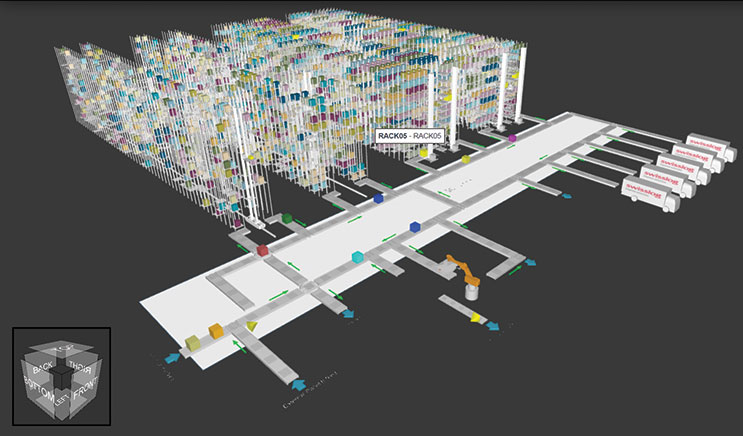
Simulation models are only as good as the data fed into them, which is where consultants will work with clients to come up with likely order volumes to be processed, both when it goes live, but also what they expect volume to be like in the future. “We’ll typically trying several different order profiles from the customer, and run those through to ensure the design is robust,” says Tejeda.
With multiple automation technologies going into some projects, simulation can spot issues like traffic congestion or unexpectedly long queue times for equipment like mobile robots or automatic guided vehicles (AGVs). “We might have a good feeling about each of them independently, but from a system standpoint, simulation can help figure out how they work together,” Tejeda says.
For Automation IO’s clients, says Schrade, the simulation project can be used to validate how much automation spend is truly needed to hit a target performance rate while avoiding low utilization. The proverbial sweet spot for elements like the number of robots or AGVs needed, or the number of cranes or carriers in an automated storage solution, can be pinpointed with simulation, says Schrade. “You always are going to find some change to the design,” he says. “You are going to be taking some elements away, or maybe adding something, to get a really clean and validated design.”
Simulation vs. emulation
A close cousin to simulation is emulation, which has the specific aim of testing automation controls and messaging prior to installation of the systems. Emulation software communicates with programmable logic controllers (PLCs) or other controls to test these functions virtually, which reduces on-site commissioning time and cost, says Phillips.
“Instead of being a simulation of the system … with emulation, we are creating, accurate, high-fidelity representations of all the hardware that’s in the system, and then we take that emulation model and we connect it to the PLCs that actually run the system and let the PLCs run the system instead of some simulation launch,” Phillips says.
The end game for emulation is to do much of the controls testing virtually, rather than at the hectic tail end of a project. “Being able to take that controls testing off the critical path at the final stages of a project, and move it up into an earlier phase of the project, is important,” says Phillips.
Additionally, says Phillips, emulation doesn’t disrupt operations, or lead to wasted energy or consumption of raw materials that might be involved in on-site controls testing.
Getting robotics right
Simulation and emulation software can be thought of as a means of having greater confidence in the expected performance of a solution, and greater speed in deploying systems, especially when emulation is also leveraged, says Thomas Evans, chief robotics technology officer for Honeywell.
“One of the challenges we have as a solution provider is customers coming to us, and saying, ‘I need to hit this rate with this robotic solution to make my return on investment (ROI). That is where we will use simulation, before we go down a dedicated development path, given specific factors around product dimension and variation in the product mix, to know with a high degree of confidence that we can meet that needed rate. And that is where part of the value of simulation comes into play—in bringing confidence during that early ideation phase,” Evans says.
Honeywell uses its own simulation software, known as Honeywell eSim, in its simulation work, leveraging a library of models it has created. When possible, these pre-existing models are used to speed up new projects for customers, though each project has unique product characteristics and volumes to test, and existing automation factors that need to be incorporated into a simulation, says Thomas.
Once the modeling is established, the simulation software can be used to quickly test what-if scenarios. With robotic piece picking simulation, says Thomas, the software can examine the impact on the piece picking rate if the products coming into the cell are singulated versus a more jumbled presentation, or the impact on rates if the system, due to seasonality or other demand patterns, will need to process a higher percentage of heavier items, or fragile items, which could slow a robotic system’s rate.
“It gives us more confidence as to what the performance will be, and what we should do with the build and design and development to meet that performance rate,” concludes Thomas.
Thomas says Honeywell uses simulation in developing new warehouse robotics solutions, as well as applying simulation to specific customer projects. All this work builds up a collection of useful models that can help Honeywell’s customers visualize the performance of a solution they are considering.
“These models we’ve created enable more in-depth conversations with our customers. They can now picture what is going to be happening in their operation, and we can look at the impact of changes, or what happens with a different [customer] product set, and that leads to a deeper understanding when working with customers,” says Thomas.
Honeywell will also use emulation to test how a solution will run on the PLCs and controls for the automation. Emulation will digitally check the messaging and interfaces to subsystems, in the virtual world, says Thomas, which cuts implementation time versus doing all the testing on-site after the hardware is installed. In developing its robotic solutions,
Honeywell also uses digital or “synthetic data” that digitally represents products that need handling, which further speeds solutions deployment, says Thomas, versus waiting to do all the testing with actual product items and vision on site in the physical world.
“Simulation is something that is helping us shorten the product development cycle, and is helping us have more accuracy in what we’re doing with prototyping. With simulation and emulation, we can shorten the time to benefit from solutions, and have a high degree of confidence that when a solution is put in place, it’s going to perform, and it’s going to mesh with your operations.”
Bridge to operations
Simulation models, once created, can be used periodically by people in end-user organizations to test new scenarios or examine how to best run systems given a new demand profile. According to Swisslog’s Hayer, only about 10% of customers that Swisslog creates simulations for will use the models later for operational decision support. “Some customers do want to use it as an operational tool, because systems are dynamic and depending order structure or order profiles, the system will behave differently and perform differently,” Hayer says.
Schrade says that among Automation IO’s clients, it’s common to use the model on an ongoing basis, perhaps to test how a warehouse’s systems will function during seasonal demand events. “Someone in operations may want to run a new order profile the day before or prior to that expected spike in demand and see where there might be pinch points in the system,” he says.
One new vendor that is applying digital twin and simulation technology within a solution aimed at operations is Synkrato. The startup’s Cloud logistics software has five core components: digital twin, adaptive slotting, a mobile app builder, Internet-of-Things (IoT) tracking, and digital labeling. Amin Sikander, president of Synkrato, says the software’s use of simulation and the digital twin concept ties directly into slotting, to arrive at more effective slotting that adapts to changing demand and supply data coming from enterprise resource planning (ERP) systems.
“Our use of digital twin is really focused on smart logistics execution,” Sikander says. “It’s not meant to be a one-time simulation.”
Using Synkrato’s software, companies can build 3D renderings of their facilities, as well as tie into changing demand and supply signals from ERP, and with that digital twin, adjust slotting as needed and see the impact.
A key benefit of the software, adds Sikander, is to easily adapt slotting to reduce travel times by shortening pick paths. The software can also be used to determine what impact the deployment of a new conveyor, or a mobile robot system, or some additional rack for fast-moving inventory, will have in terms of travel time reduction and picking efficiencies.
“Those are the types of problems we are trying to solve,” says Sikander. “Our solution is meant to actively adapt your warehouse to changing demand and supply patterns to make it more efficient.”

Article Topics
Software News & Resources
C-Suite Interview with Frank Jewell of Datex, Leading the Way in the Material Handling Industry Give your warehouse management systems (WMS) a boost Learn from lift truck service history How Automation and Software are Solving Supply Chain Productivity Challenges We love research Chamberlain Group Expands myQ Ecosystem with Launch of myQ Enterprise 2024 Automation Study: How automation is transforming the warehousing landscape More SoftwareLatest in Materials Handling
ASME Foundation wins grant for technical workforce development The (Not So) Secret Weapons: How Key Cabinets and Asset Management Lockers Are Changing Supply Chain Operations MODEX C-Suite Interview with Harold Vanasse: The perfect blend of automation and sustainability Consultant and industry leader John M. Hill passes on at age 86 Registration open for Pack Expo International 2024 Walmart chooses Swisslog AS/RS and software for third milk processing facility NetLogistik partners with Vuzix subsidiary Moviynt to offer mobility solutions for warehouses More Materials HandlingAbout the Author
Subscribe to Materials Handling Magazine

Find out what the world's most innovative companies are doing to improve productivity in their plants and distribution centers.
Start your FREE subscription today.
April 2024 Modern Materials Handling

Latest Resources


